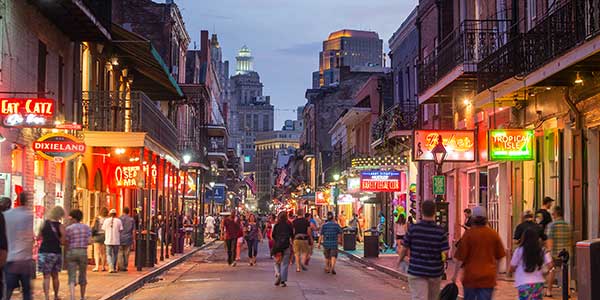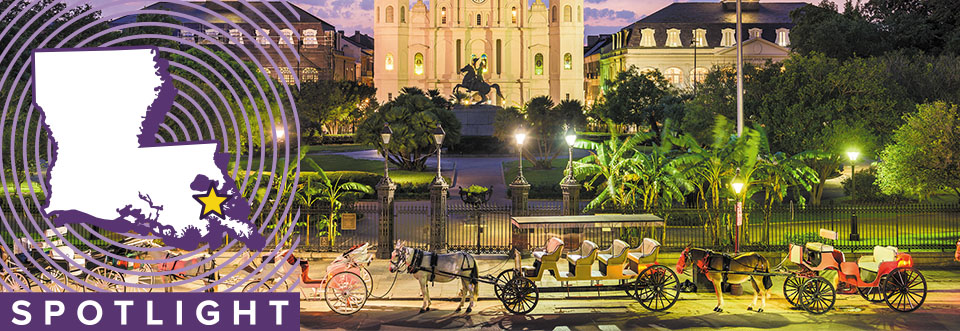New Orleans
Tour a city that resonates with history, jazz and fine restaurants
Mardi Gras isn’t the only reason to visit New Orleans. Streetcars, historic neighborhoods, jazz and ocean-to-table seafood from the Gulf of Mexico will keep your schedule full and your taste buds busy.
A Kaleidoscope of Cultures
Known all over the world for its patchwork of cultural influences, New Orleans entices millions of people who come each year to the fabled Crescent City on the Mississippi River. The Pelican State’s largest town never fails to disappoint, putting on a rollicking party that never seems to end. The streets of the city reach fever pitch during Mardi Gras, the traditional January-February celebration renowned for its over-the-top costumes, festive parades and decadent confections, including king cake (which contains a baby symbolizing luck and prosperity).
New Orleans’ history is as complex as the ingredients found in a hot bowl of gumbo. Founded in 1718 by French settlers, the burgeoning port city was later ceded to the Spanish, who ruled it for 40 years before relinquishing it back to the French. The Louisiana Purchase in 1803 placed the town in the hands of the United States, and it grew rapidly over the years as a vital North American shipping hub.
You’ll witness elements of each of these and other cultures throughout New Orleans in its architecture, area plantations and historic neighborhoods, including places like the famed French Quarter and Faubourg Tremé. The latter is the oldest African-American neighborhood in the U.S., named after French real estate developer Claude Tremé, who settled in New Orleans in 1783.
New Orleans has had its share of battle scars. In 1815, Andrew Jackson led American forces in repelling invading British forces during the Battle of New Orleans, cementing U.S. victory of the War of 1812. Visitors can walk in the footsteps of the combatants at Chalmette Battlefield, located on the east side of town on the banks of the Mississippi.
In 1862, the Union forces invaded the city during the Civil War, holding New Orleans under martial law and inspiring an anti-government sentiment among locals that lasted well past Reconstruction. Today, Civil War monuments remain throughout the city.
The city’s biggest test came with the 2005 landfall of Hurricane Katrina, which destroyed much of the town when levees failed to hold back floodwaters. A combination of public and private funding, along with millions of tourists who spent their vacation dollars in New Orleans, helped contribute to the city’s resurgence as a choice destination.

Jazz and Jambalaya
New Orleans proudly touts its status as the birthplace of jazz music. The New Orleans Jazz National Historical Park preserves this vibrant history. Stop by its visitor center and the Old U.S. Mint for information on events like the Jazz & Heritage Festival, Satchmo Summerfest and other chances to experience a truly original American music form. Browse exhibits dedicated to local jazz legends, from Charles “Buddy” Bolden to the legendary Louis “Satchmo” Armstrong.
Jazz clubs in New Orleans are as plentiful as jambalaya recipes. Whether in the French Quarter or elsewhere in town, you’re bound to find a place where live music is playing. If you’re lucky, you can enjoy fantastic food and the dynamic sounds of jazz notes at the same time, since many New Orleans eateries also have house bands.
Jazz isn’t the only game in town. New Orleans’ Louisiana Philharmonic Orchestra is the oldest full-time musician-governed and collaboratively operated orchestra in the United States. Opera dates back some 200 years in New Orleans, and there are a number of venues throughout the city that put on concerts dedicated to this classic form of music.
Big Easy Neighborhoods
Each New Orleans community boasts a distinct identity. A great place to start is the gorgeous and historic Garden District, which is characterized by gigantic Italianate, Greek Revival and Victorian homes. The neighborhood is perhaps best known as the terminus of the famous Saint Charles Streetcar line, which many visitors will recognize from the iconic play and film, “A Streetcar Named Desire.” Many of the city’s historic streets retain their Gallic names, and French terminology pops up from time to time in the local vernacular.
Most visitors base themselves in or near the French Quarter, which puts them within easy reach of popular sites. Don’t miss a visit to Jackson Square, which is presided over by the Cathedral-Basilica of Saint Louis, the oldest continuously operating cathedral in the country. The square is full of interesting characters and quaint shops — including one devoted entirely to Tabasco sauce, Louisiana’s best-known export. The square also doubles as a stage for a regular rotation of musicians and street performers, and you’ll find plenty of local artisans selling paintings of the city’s gorgeous streets. It’s also the best place to hire a horse-drawn carriage to take you on a leisurely tour around the French Quarter’s cobblestone streets.

Tour Louisiana
The Creole and Cajun Connection
Don’t make the mistake of thinking that Creole and Cajun are interchangeable monikers. New Orleans locals are quick to point out the distinctions in the two cultures. However, the cultures do overlap when it comes to food. Both Cajun and Creole cuisine enjoy influences from African, German, Native American and Spanish cooking. You’ll find that Cajun tastes lean toward dishes that are full-bodied or blackened (i.e., blackened red fish), while the culinary preferences defining Creole cooking is heightened by use of a vast array of herbs, spices and sauces. A Creole meal is often served over several courses, reflecting European roots, while Cajun dishes are usually one-pot meals.
Then there are times when all the rules go out the window. A classic New Orleans dish, étouffée, traditionally prepared as shellfish over rice, is served in New Orleans as both a Creole and Cajun entrée. Another example is boudin, (BOO-dan) a sausage with Cajun origins and Creole variations, along with more than one way to pronounce it. But don’t fret over how to say it — just sit down and enjoy it. You’ll have no trouble finding eateries with all variations of native cuisine.
For More Information
New Orleans Convention and Visitors Bureau
800-672-6124
www.neworleanscvb.com
Louisiana Office of Tourism
800-677-4082
www.louisianatravel.com




